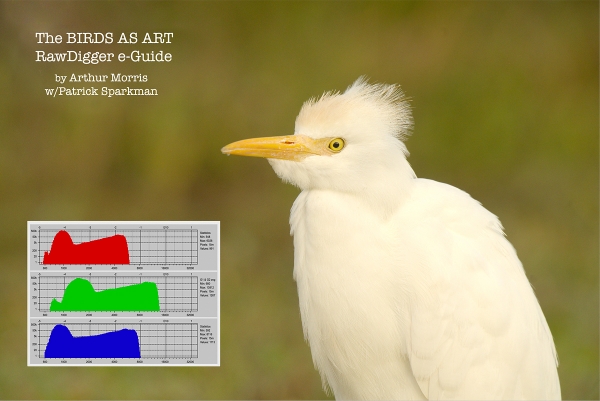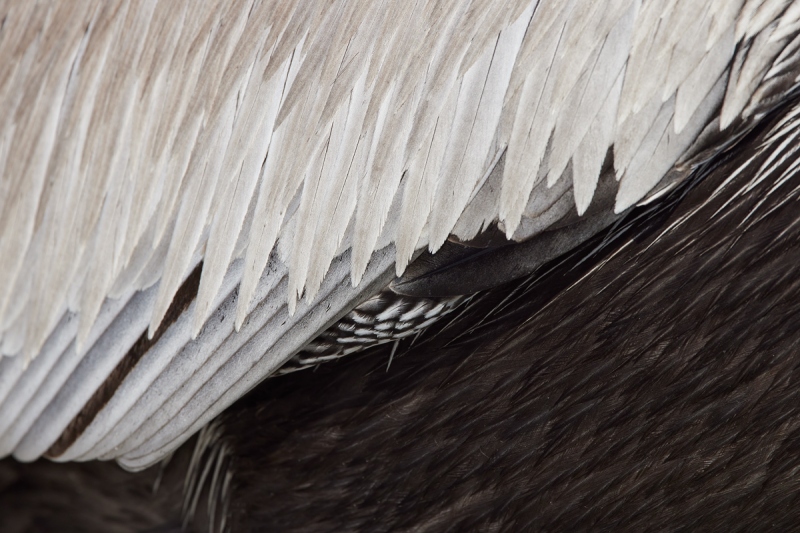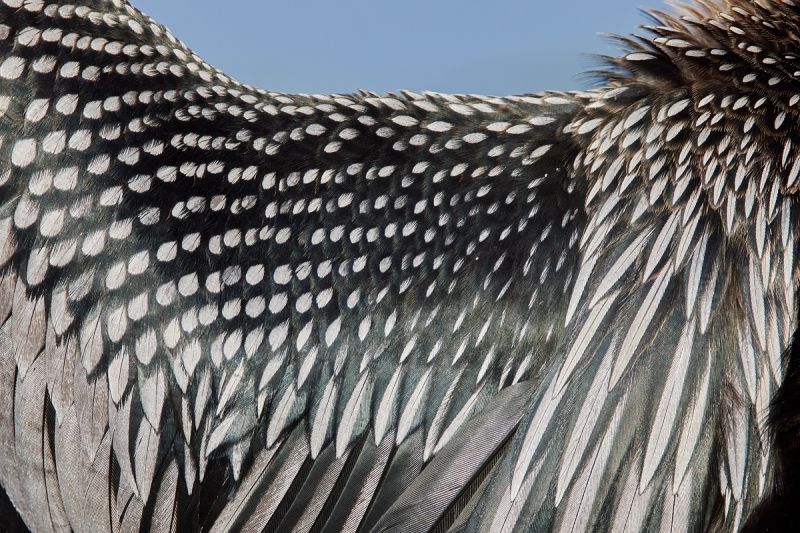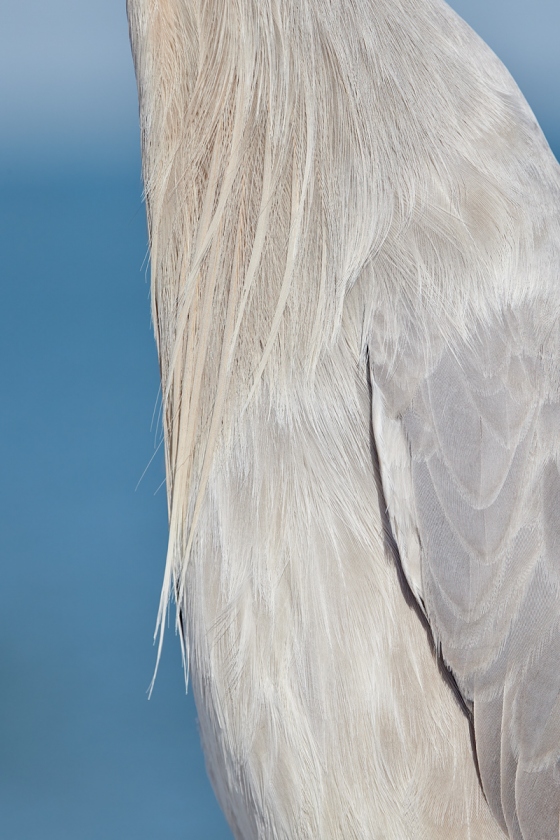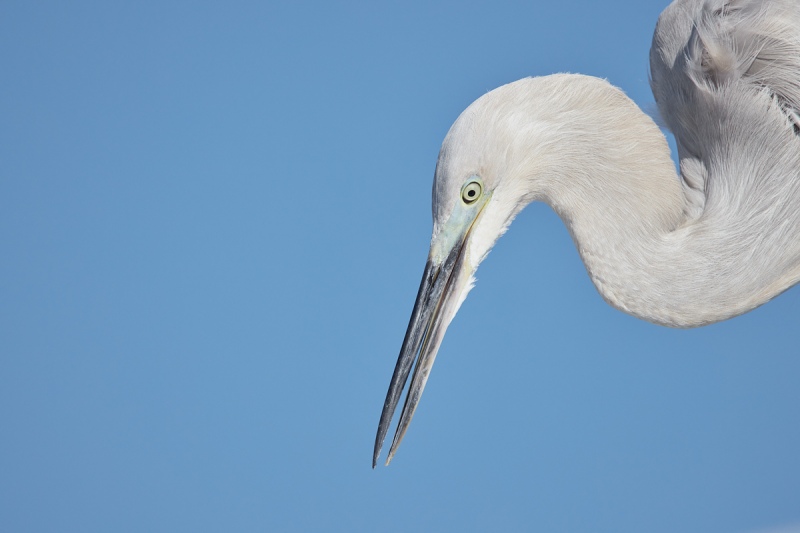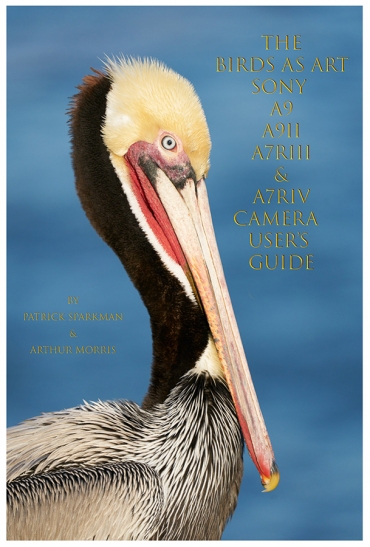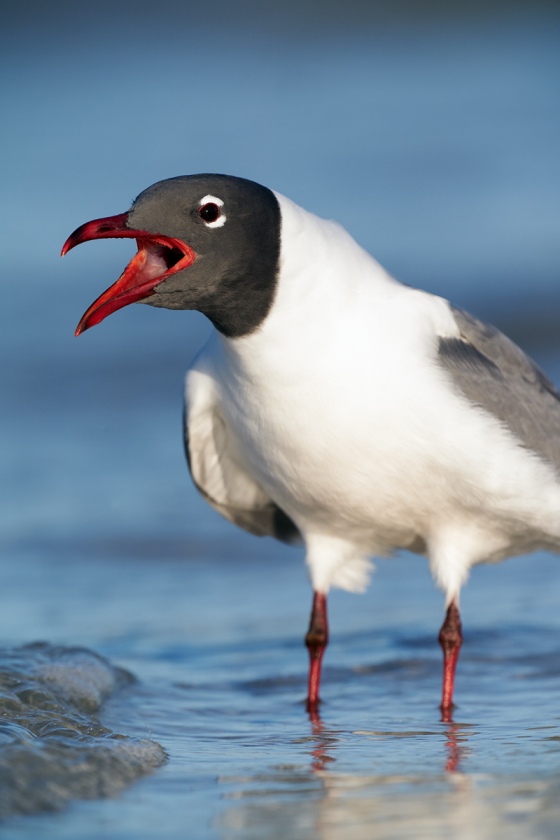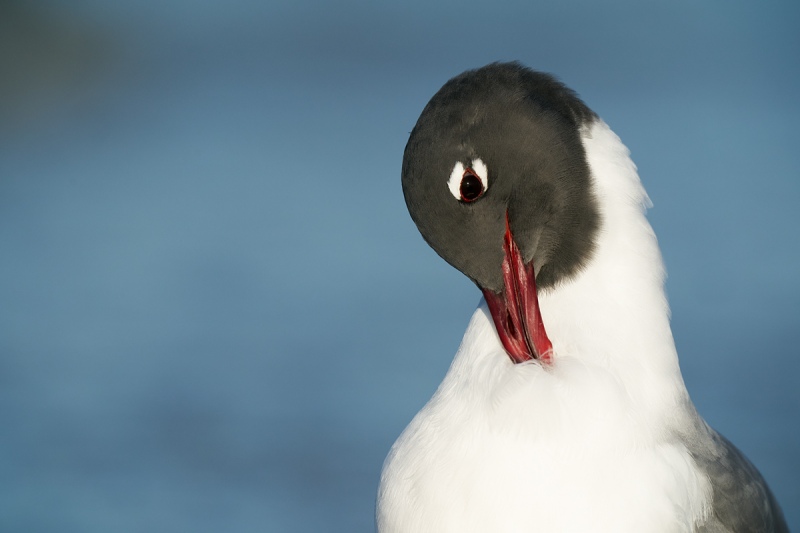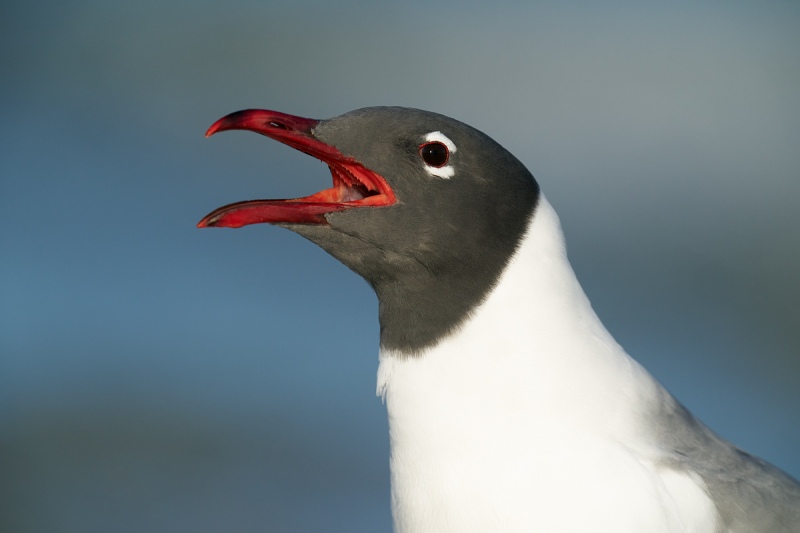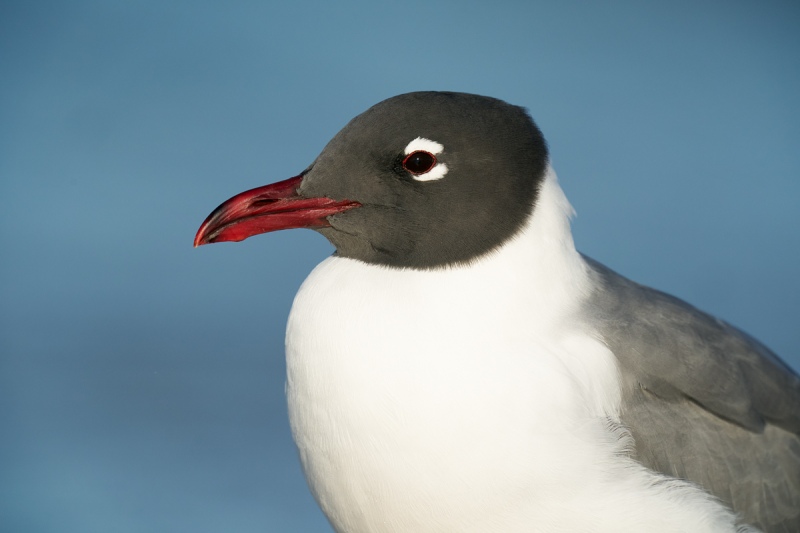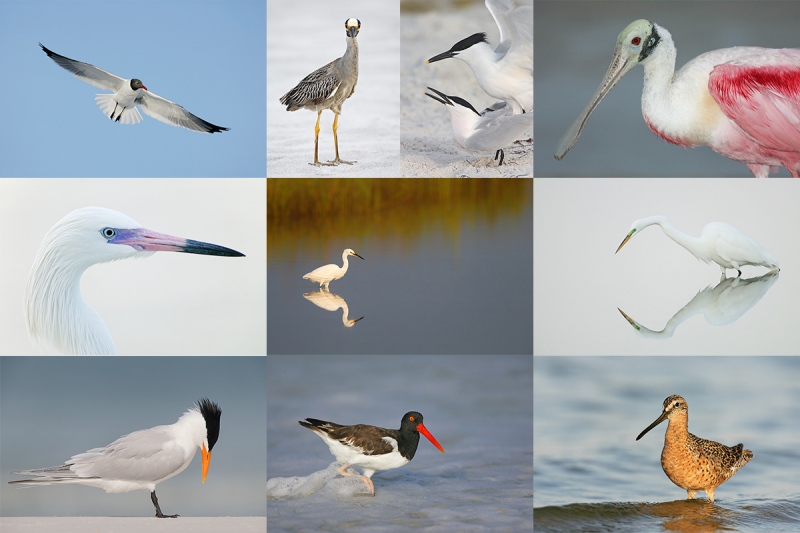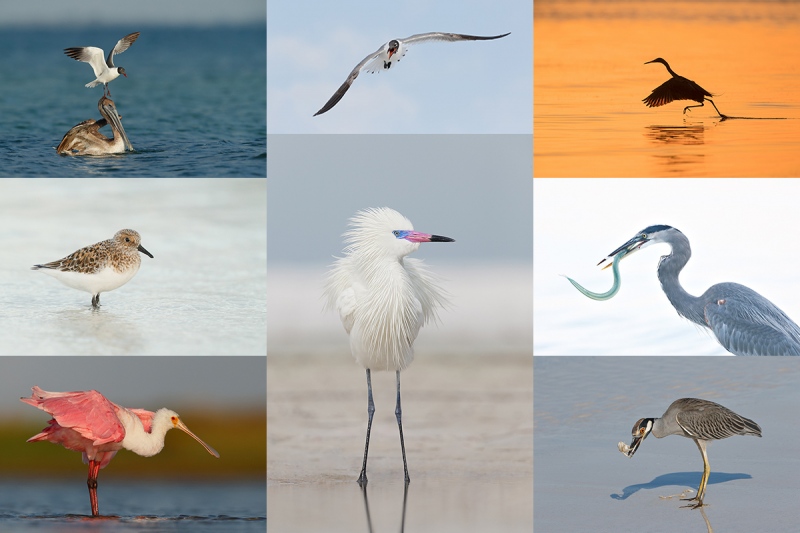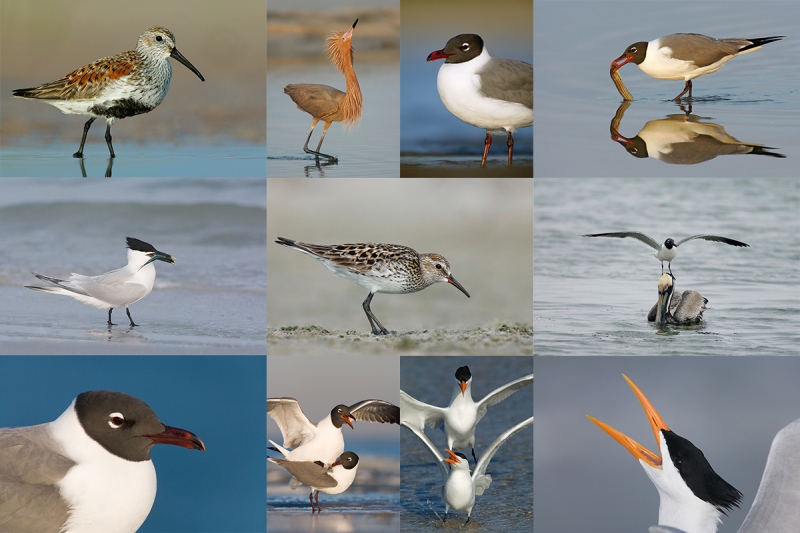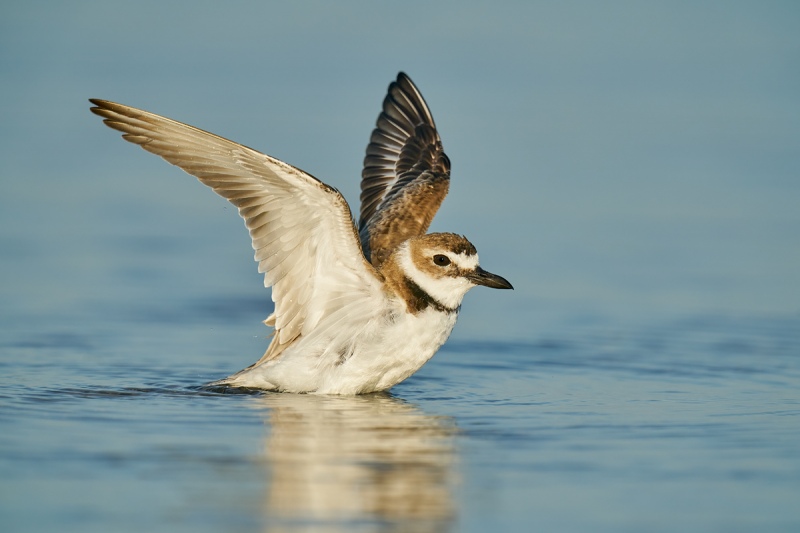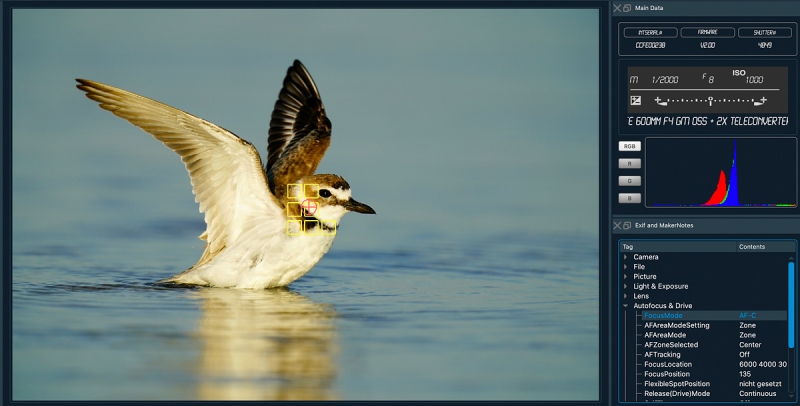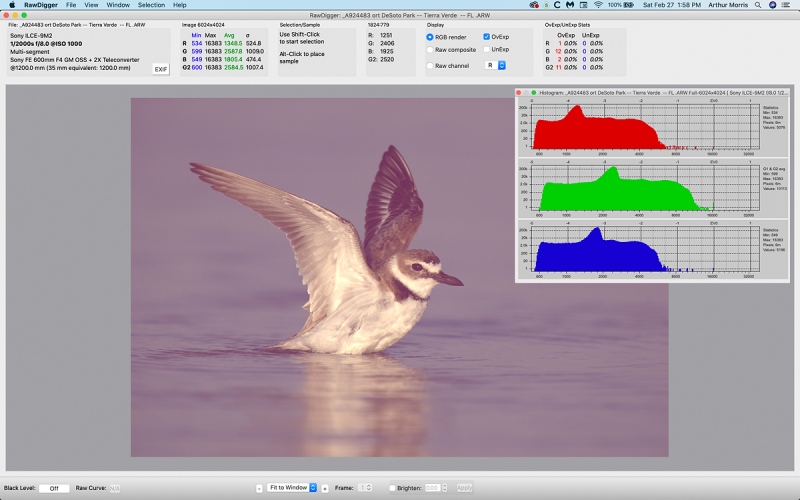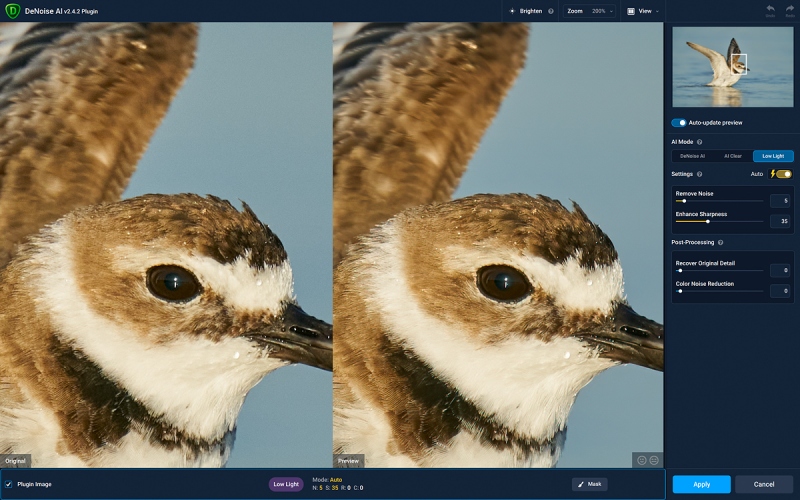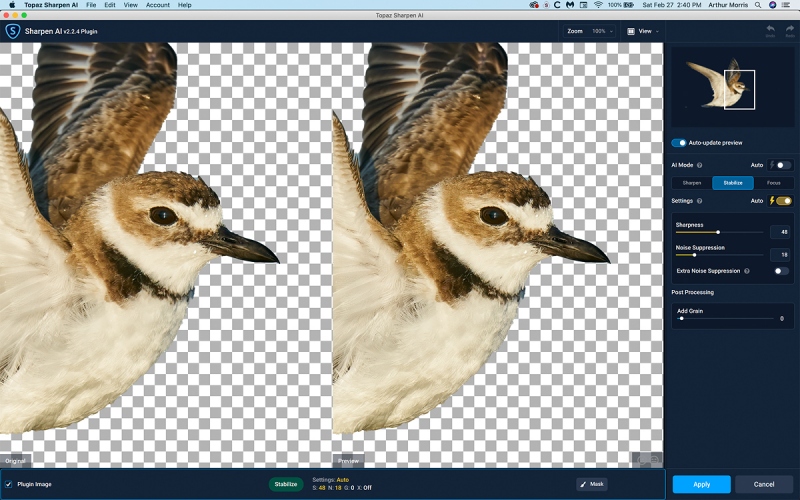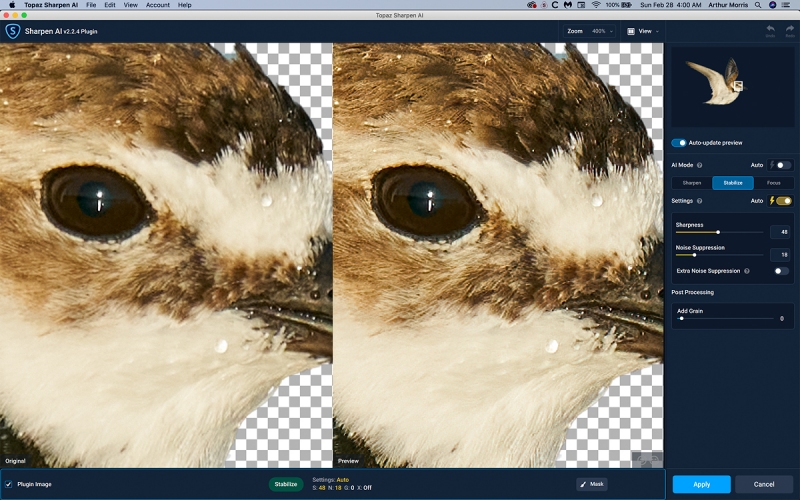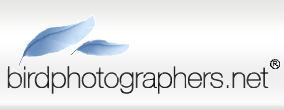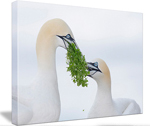March 2nd, 2021 Canon R6 Bodies in Stock now at Bedfords/R5 Bodies on the Way!
Steve Elkins asked me to let you know that he is receiving a good number of Canon EOS-R6 bodies today. Get yours by clicking here. Enter the BIRDSASART discount code at checkout, save 3%, and enjoy free second-day air Fed-Ex shipping. And shoot me your receipt to receive your free copy of the R5/R6 AF e-Guide and save $65.00 off the price of the R5 User’s e-Guide.
Six R5 Bodies are on the way as well …
What’s Up?
Right before I got out of my SUV to pick up and pack up the very still raccoon, I saw that about 100 or so Cattle Egrets that had been roosting on the pier railings were taking off and flying to the South Peninsula, so I pulled my vehicle up 100 yards in an effort to get some hand held flight shots from the driver’s seat. I glanced in the driver’s side mirror and saw that several vultures were feeding on the carcass. Lesson learned: my vehicle had been too close to the long-deceased raccoon.
I spent a great deal of time answering e-mails, responding to comments on yesterday’s blog post, and working on an article entitled A Personal Account: The Photographic Benefits of the COVID 19 Pandemic for the Georgia Nature Photographer Association Newsletter. After being postponed a year, I will be keynoting, speaking, and teaching at the GNPA Expo at Jekyll Island, Georgia — April 7-10, 2022.
I had a great swim in a now very warm and delightful pool. Summer has come early to central Florida. I did make it down to the lake just before sunset for a short photo session. With the wind from the southwest, I tried a new plan that did not involve birds landing directly away from me. I had a few good chances.
Today is Tuesday 2 March 2021. The forecast for ILE this morning is for mostly cloudy skies with a light north/northeast wind. I will be heading down to the lake for a bit.
Wherever you are and whatever you are doing, I hope that you have a great day.
This blog post took 1 1/2 hours to prepare and makes seventy-one days in a row with a new one. Please remember …
Please Remember
With income from IPTs now at zero, please, if you enjoy and learn from the blog, remember to use one of my two affiliate programs when purchasing new gear. Doing so just might make it possible for me to avoid having to try to get a job as a Walmart greeter and will not cost you a single penny more. And if you use Bedfords and remember to enter the BIRDSASART code at checkout, you will save 3% on every order and enjoy free second-day air shipping. In these crazy times — I am out at least forty to sixty thousand dollars so far due to COVID 19 (with lots more to come) — remembering to use my B&H link or to shop at Bedfords will help me out a ton and be greatly appreciated. Overseas folks who cannot order from the US because of import fees, duties, and taxes, are invited to help out by clicking here to leave a blog thank you gift if they see fit.
Great Topaz News!
Folks who use the BAA Topaz link to purchase Sharpen AI, DeNoise AI, or the Utility Bundle (or any other Topaz plug-ins) will receive a 15% discount by entering the ARTHUR15 code at checkout. If the stuff is on sale (as it usually is), you save 15% off of the sale price! To get the discount you must use my link and you must enter the discount code. Be sure to start with this link.
Those who purchase Sharpen AI, DeNoise AI, or any other Topaz plug-ins using my link and then entering the ARTHUR15 code at checkout can e-mail to request a short Getting Started with Topaz e-Guide. Please include a copy of your Topaz receipt that shows the discount. Aside from the basics, the guide explains how to install the plug-ins so that they appear in the Photoshop Filter Menu.
|
|
RawDigger e-Guide with Two Videos
|
The RawDigger e-Guide with Two Videos
by Arthur Morris with Patrick Sparkman
The RawDigger e-Guide was created only for serious photographers who wish to get the absolute most out of their raw files.
Patrick and I began work on the guide in July 2020. At first we struggled. We asked questions. We learned about Max-G values. We puzzled as to why the Max G values for different cameras were different. IPT veteran Bart Deamer asked lots of questions that we could not answer. We got help from RawDigger creator Iliah Borg. We learned. In December, Patrick came up with an Adapted Histogram that allows us to evaluate the exposures and raw file brightness for all images created with all digital camera bodies from the last two decades. What we learned each time prompted three complete beginning to end re-writes.
The point of the guide is to teach you to truly expose to the mega-Expose-to-the-Right so that you will minimize noise, maximize image quality, best utilize your camera’s dynamic range, and attain the highest possible level of shadow detail in your RAW files in every situation. In addition, your properly exposed RAW files will contain more tonal information and feature the smoothest possible transitions between tones. And your optimized images will feature rich, accurate color.
We teach you why the GREEN channel is almost always the first to over-expose. We save you money by advising you which version of RawDigger you need. We teach you how to interpret the Max G values for your Canon, Nikon, and SONY camera bodies. It is very likely that the Shock-your-World section will shock you. And lastly — thanks to the technical and practical brilliance of Patrick Sparkman — we teach you a simple way to quickly and easily evaluate your exposures and raw file brightness using an Adapted RawDigger histogram.
The flower video takes you through a session where artie edits a folder of images in Capture One while checking the exposures and Max-G values in RawDigger. The Adapted Histogram video examines a series of recent images with the pink histograms and covers lots of fine points including and especially how to deal with specular highlights. The directions for setting up the Adapted Histogram are in the text.
If we priced this guide based on how much effort we put into it, it would sell it for $999.00. But as this guide will be purchased only by a limited number of serious photographers, we have priced it at $51.00. You can order yours here in the BAA Online Store.
Canon EOS R5 Camera User’s e-Guide
On Thursday, I sent out about a dozen copies of the almost finished Canon EOS R5 Camera User’s e-Guide for review to folks who had previously gotten free copies of the R5/R6 AF e-Guide by using my affiliate links to purchase their Canon mirrorless gear. In the same vein, I will be contacting everyone who purchased the R5/R6 AF e-Guide on Monday.
Because the camera and the Menus are so complex, this guide has required a ton of research, a lot of time, and a lot of effort (and will continue to do so until it is complete). It should be finished by the first week in March. 2021. The final update of the R5/R6 AF e-Guide has become part of the complete Camera User’s e-Guide; it will be revised if warranted.
The complete Camera User’s guide will sell for $75.00. Folks who purchased their Canon gear using my links will receive a $65.00 discount; the guide will cost them a nominal $10.00. Folks who spent more than $7500.00 on Canon mirrorless gear using either of my affiliate links (B&H or Bedfords), will receive the User’s Guide for free. Folks who purchased the R5/R6 AF e-Guide will receive a $10.00 discount on the User’s e-Guide. The best news is that the end is in sight.
New and Better Bedfords Discount Policy!
You can now save 3% on all of your Bedfords photo gear purchases by entering the BIRDSASART coupon code at checkout. Your discount will be applied to your pre-tax total. In addition, by using the code you will get 2nd day air shipping via Fed Ex.
Grab a Nikon AF-S Teleconverter TC-14E III and save $14.99. Purchase a Canon EOS R5 and your discount will be $116.97. Purchase a Sony FE 600mm f/4 GM OSS lens and save a remarkable $389.94! Your Bedford’s purchase no longer needs to be greater than $1,000.00 for you to receive a discount. The more you spend, the more you save.
Money Saving Reminder
Many have learned that if you need a hot photo item that is out of stock at B&H and would enjoy free second-day air shipping, your best bet is to click here, place an order with Bedfords, and enter the coupon code BIRDSASART at checkout. If an item is out of stock, contact Steve Elkins via e-mail or on his cell phone at (479) 381-2592 (Central time). Be sure to mention the BIRDSASART coupon code and use it for your online order to save 3% and enjoy free 2nd-day air shipping. Steve has been great at getting folks the hot items that are out of stock at B&H and everywhere else. The wait lists at the big stores can be a year or longer for the hard to get items. Steve will surely get you your gear long before that. For the past year, he has been helping BAA Blog folks get their hands on items like the SONY a9 ii, the SONY 200-600 G OSS lens, the Canon EOS R5, the Canon RF 100-500mm lens, and the Nikon 500mm PF. Steve is personable, helpful, and eager to please.


Gear Questions and Advice
Too many folks attending BAA IPTs (remember those?) and dozens of photographers whom I see in the field and on BPN, are–out of ignorance–using the wrong gear especially when it comes to tripods and more especially, tripod heads… Please know that I am always glad to answer your gear questions via e-mail. Those questions might deal with systems, camera bodies, accessories, and/or lens choices and decisions.
|
|
|
This image was created on 26 February 2021 at Fort DeSoto Park, Tierra Verde FL. I used the handheld Canon RF 100-500mm f/4.5-7.1L IS USM lens with the Canon Extender RF 1.4x (at 700mm) and the highly touted 45MP Canon EOS R5 Mirrorless Digital camera body. ISO 800. Exposure determined via test image/histogram evaluation: 1/640 sec. at f/16 (stopped 1 1/3 stops) in Manual mode. RawDigger showed this one to be perfect. Maybe I am learning … AWB at 9:22am on a sunny morning.
1-Point/AI Servo AF performed just fine.
Image #1: What is it?
|
In the recent Killer Afternoon at DeSoto. RF 100-500 Close-focusing MFD. Age and ID Quiz: Earn a $25.00 credit in the BAA Online Store. And ask yourself … blog post here, I wrote:
Age and ID Quiz: Earn a $25.00 credit in the BAA Online Store
To earn a $25.00 credit in the BAA Online Store be the first to leave a comment on identifying the species of bird seen in Images #1 and 2 and signifying “adult” or “juvenile.” I will withhold judgement for two days so that if the first person gets it right, the rest of you can still have fun by agreeing or disagreeing. 2nd place gets zip.
I thought that Image #1, above, was easy-peasy. It was not. While five folks correctly identified the bird as an adult Brown Pelican, four others thought that it was an Anhinga … See Image #2 below.
|
|
|
This image was created on 11 November 2021 Lakeland, FL. I used the handheld Canon RF 100-500mm f/4.5-7.1L IS USM lens with the Canon Extender RF 1.4x (at 700mm) and the highly touted 45MP Canon EOS R5 Mirrorless Digital camera body. ISO 1250. Exposure determined by test image histogram evaluation; RawDigger showed some over-exposed feather shafts: 1/500 sec. at f/16 (stopped down 1 1/3 stops) in Manual mode. AWB at 8:28am on sunny morning.
Face detection + Tracking/AI Servo AF was active at the moment of exposure and actively 81 AF points on the upper center of the wing. Click the image to see a larger version.
Image #1: Anhinga wing feather detail
|
Anhinga Feather Detail
A quick glance at any North American field guide would have shown that the bird in Image #1 was not an Anhinga; even young Anhingas have the silver on black pattern on the upper wings. The R5, with its four-foot minimum focusing distance, is a great tool for creating tight, abstract images of large, tame birds. Note that it is best to stop down from one to two stops when working at very close range in order to have enough depth-of-field to cover the curved surface of the bird’s bodies.
Fine Feather Detail Image Processing
Both of the images above were first put through Topaz DeNoise AI on Low Light, and then through Topaz Sharpen AI on Stabilize. The latter shows us that we are not as steady as we think we are even when hand holding.
|
|
|
This image was created on 26 February 2021 at Fort DeSoto Park, Tierra Verde FL. I used the handheld Canon RF 100-500mm f/4.5-7.1L IS USM lens with the Canon Extender RF 1.4x (at 480mm) and the highly touted 45MP Canon EOS R5 Mirrorless Digital camera body. ISO 500. Exposure determined via test image/histogram evaluation: 1/640 sec. at f/16 (stopped 1 2/3 stops ???) in Manual mode. RawDigger showed this one to be less than 1/3-stop under. AWB at 9:34am on a sunny morning.
Again, 1-Point/AI Servo AF performed just fine.
Image #3: What is it?
|
A Lot Tougher
The second image on the other hand, was a lot tougher. The hint of auburn in the ruff clearly indicates Reddish Egret. And the light grey subterminal fringes on the covert feathers make this bird a juvenile. Scroll down to learn more about this unique individual.
And the Winner Is!
The winner of the ID Quiz is veteran bird photographer, good friend, and multiple IPT veteran Cliff Beittel. His $25.00 credit in the BAA Online store is now on the books.
|
|
|
This image was created on 26 February 2021 at Fort DeSoto Park, Tierra Verde, FL. I used the handheld Canon RF 100-500mm f/4.5-7.1L IS USM lens with the Canon Extender RF 1.4x (at 700mm) and the highly touted 45MP Canon EOS R5 Mirrorless Digital camera body. ISO 800. Exposure determined by test image histogram evaluation: RawDigger showed the exposure to be perfect: 1/1600 sec. at f/10 (wide open) in Manual mode. AWB at 9:15am on sunny morning.
Face detection + Tracking/AI Servo AF was active at the moment of exposure performed perfectly by nailing the eye squarely. Click on the image to see a larger version.
Image #4: Reddish Egret juvenile
|
Leucism
Leucism (loo’-siz-um) refers to a wide variety of genetic conditions that result in the partial loss of pigmentation in an animal—causing white, pale, or patchy coloration of the skin, hair, feathers, scales, or cuticles (but not the eyes). The adjective is leucistic (loo-si-stuhk).
One Strange Bird …
As many of you know, there are two color morphs of Reddish Egret, a dark form and a white form. There are lots of photographs of juvenile dark morph Reddish Egrets online, and very, very few of juvenile white morphs. I am currently trying to track some of those down so that I can get my hands on larger, more detailed versions.
The bird in question here is many, many shades lighter than a typical juvenile dark morph Reddish Egret. So what is it? I do not know. It is possible that it is a leucistic dark morph juvenile Reddish Egret. Or, it is possible that some juvenile white morph Reddish Egrets are a very light grey (like the bird in Images #3 and $4 above), and then become all white when they molt into their first adult plumage. In a phone conversation last night with Richard Crossley, the Brit agreed that that might very well be a possibility. He stressed that there is an amazing amount of stuff that we simply do not know about the identification and molt sequences of even the most common species.
When I learn some more, I will be posting additional images of this bird.
Typos
In all blog posts and Bulletins, feel free to e-mail or to leave a comment regarding any typos or errors.
March 1st, 2021 Your Favorite
All are invited to leave a comment letting us know which of today’s four featured images they like best. As always, please let us know why you made your choice. Comparative comments are also welcome. I will share my favorites in order from one to four here in a few days. Along with my reasons.
What’s Up?
I had a great Sunday morning with R5/RF 100-500 shooter Steve King. We both learned a ton. We photographed Laughing and Ring-billed Gulls, Brown Pelicans in flight, and several species of shorebirds (including two tame Whimbrels!), and several species of egrets and herons. While it was mostly sunny, we did have a few clouds come over at times. This gave Steve the opportunity learn the differences involved when determining the correct exposures in bright sun as compared to cloudy conditions. Steve also learned about staying on sun angle, keeping his left palm to the sky when hand holding, and about the strategies used when photographing birds flapping after their baths. And I have an idea involving the Lock Button on the R5 to eliminate an annoying problem with the R5; I will be exploring a possible solution soon. I created 1866 still-to-be edited images.
Steve kindly loaned me his RF 2X teleconverter. I was pretty much astounded by the R5/RF 100-500/2RF 2X TC combination. Face Detection plus Tracking AF was fast, responsive, and accurate. And a quick peek at the images revealed that they are astoundingly sharp. I will be sharing some of them with you here soon. While a 600-1000mm zoom lens is nothing to sneeze at, you need to pick your spots carefully; the wide open aperture at 500mm is f/14. In the bright sun, I worked at ISO 800 and 1000, used shutter speeds ranging from 1/500 to 1/1000 second, and apertures ranging from f/14 to f/20. Do understand that precise framing while hand holding at 1000mm is a huge challenge, especially if the birds are moving at all. In low light this combination will require the use of exceedingly high ISOs … All that said, I will almost surely be purchasing a Canon Extender RF 2x from Steve Elkins at Bedfords this week.
I was glad to learn that Anthony Ardito sold his SONY a7r iv body for a BAA record-low $1998.00. The winner of the $25.00 BAA store-credit ID quiz will be revealed tomorrow.
Today is Monday 1 March 2021; can you believe that it is already March??? The forecast for this morning is “partly cloudy” with south winds. I peeked out the back door at 7:00am to see clear skies everywhere. Though I have a ton of work to do, I will head down to the lake soon for a short session.
It is now 8:00am and I am sitting in my SUV working on finishing this blog post. I am parked, square to the sun, 60 feet from the long-dead road-killed raccoon, liberated from the fridge for just this occasion. There is a light breeze from the south so all I need is a few interested vultures, or a hungry Bald Eagle …
8:22am: I missed an incoming Black Vulture. I snapped a few frames of it standing near the raccoon but after a few minutes, it flew off. Back to the blog post.
8:36am: I saw an adult Bald Eagle flying right at the raccoon. I lowered the exposure (ISO) three clicks from the vulture exposure as I rated the rig to my eye, but as I had been photographing the raccoon alone I had an off-centered single-AF point. By the time I got where I needed to be, the eagle had flown well past sun angle. Had I been a bit more familiar with my Canon gear I would have gotten a few pretty good frames …
8:50am: a young Bald Eagle flew by at a distance, once having a brief interaction with an Osprey.
8:56am: a dozen Turkey Vultures circled overhead …
9:02am: two landed. One took off.
9:09am: I am about to hit Publish and give up for today. Perhaps I should have brought down some smoked salmon skins and a defrosted fish head or two … Now that would have been cheating!
Wherever you are and whatever you are doing, I hope that you have a great day.
I should have mentioned yesterday that my fine dinner at Left Bank Bistro was the first time I had eaten in a restaurant in more than a year. And that the money I spent was more than I had ever spent on a dining-alone meal.
This blog post took two hours to prepare and makes seventy days in a row with a new one. Please remember …
Please Remember
With income from IPTs now at zero, please, if you enjoy and learn from the blog, remember to use one of my two affiliate programs when purchasing new gear. Doing so just might make it possible for me to avoid having to try to get a job as a Walmart greeter and will not cost you a single penny more. And if you use Bedfords and remember to enter the BIRDSASART code at checkout, you will save 3% on every order and enjoy free second-day air shipping. In these crazy times — I am out at least forty to sixty thousand dollars so far due to COVID 19 (with lots more to come) — remembering to use my B&H link or to shop at Bedfords will help me out a ton and be greatly appreciated. Overseas folks who cannot order from the US because of import fees, duties, and taxes, are invited to help out by clicking here to leave a blog thank you gift if they see fit.
|
|
|
134 sold to rave reviews.
The SONY e-Guide by Patrick Sparkman and Arthur Morris
|
The Sony Camera User’s e-Guide (and Videos)
Click here to purchase the guide with one Camera Set-up Video. Be sure to e-mail us by clicking here to specify your camera body so that we can send you a link for the correct video.
Click here to purchase the guide with two Camera Set-up Videos. Be sure to e-mail us by clicking here to specify your two camera bodies so that we can send you links for the correct videos.
Click here to learn more about the SONY e-Guide.
Folks who have used my B&H affiliate links or purchased their SONY gear are invited to e-mail for discount information.
|
|
RawDigger e-Guide with Two Videos
|
The RawDigger e-Guide with Two Videos
by Arthur Morris with Patrick Sparkman
The RawDigger e-Guide was created only for serious photographers who wish to get the absolute most out of their raw files.
Patrick and I began work on the guide in July 2020. At first we struggled. We asked questions. We learned about Max-G values. We puzzled as to why the Max G values for different cameras were different. IPT veteran Bart Deamer asked lots of questions that we could not answer. We got help from RawDigger creator Iliah Borg. We learned. In December, Patrick came up with an Adapted Histogram that allows us to evaluate the exposures and raw file brightness for all images created with all digital camera bodies from the last two decades. What we learned each time prompted three complete beginning to end re-writes.
The point of the guide is to teach you to truly expose to the mega-Expose-to-the-Right so that you will minimize noise, maximize image quality, best utilize your camera’s dynamic range, and attain the highest possible level of shadow detail in your RAW files in every situation. In addition, your properly exposed RAW files will contain more tonal information and feature the smoothest possible transitions between tones. And your optimized images will feature rich, accurate color.
We teach you why the GREEN channel is almost always the first to over-expose. We save you money by advising you which version of RawDigger you need. We teach you how to interpret the Max G values for your Canon, Nikon, and SONY camera bodies. It is very likely that the Shock-your-World section will shock you. And lastly — thanks to the technical and practical brilliance of Patrick Sparkman — we teach you a simple way to quickly and easily evaluate your exposures and raw file brightness using an Adapted RawDigger histogram.
The flower video takes you through a session where artie edits a folder of images in Capture One while checking the exposures and Max-G values in RawDigger. The Adapted Histogram video examines a series of recent images with the pink histograms and covers lots of fine points including and especially how to deal with specular highlights. The directions for setting up the Adapted Histogram are in the text.
If we priced this guide based on how much effort we put into it, it would sell it for $999.00. But as this guide will be purchased only by a limited number of serious photographers, we have priced it at $51.00. You can order yours here in the BAA Online Store.
Canon EOS R5 Camera User’s e-Guide
On Thursday, I sent out about a dozen copies of the almost finished Canon EOS R5 Camera User’s e-Guide for review to folks who had previously gotten free copies of the R5/R6 AF e-Guide by using my affiliate links to purchase their Canon mirrorless gear. In the same vein, I will be contacting everyone who purchased the R5/R6 AF e-Guide on Monday.
Because the camera and the Menus are so complex, this guide has required a ton of research, a lot of time, and a lot of effort (and will continue to do so until it is complete). It should be finished by the first week in March. 2021. The final update of the R5/R6 AF e-Guide has become part of the complete Camera User’s e-Guide; it will be revised if warranted.
The complete Camera User’s guide will sell for $75.00. Folks who purchased their Canon gear using my links will receive a $65.00 discount; the guide will cost them a nominal $10.00. Folks who spent more than $7500.00 on Canon mirrorless gear using either of my affiliate links (B&H or Bedfords), will receive the User’s Guide for free. Folks who purchased the R5/R6 AF e-Guide will receive a $10.00 discount on the User’s e-Guide. The best news is that the end is in sight.
New and Better Bedfords Discount Policy!
You can now save 3% on all of your Bedfords photo gear purchases by entering the BIRDSASART coupon code at checkout. Your discount will be applied to your pre-tax total. In addition, by using the code you will get 2nd day air shipping via Fed Ex.
Grab a Nikon AF-S Teleconverter TC-14E III and save $14.99. Purchase a Canon EOS R5 and your discount will be $116.97. Purchase a Sony FE 600mm f/4 GM OSS lens and save a remarkable $389.94! Your Bedford’s purchase no longer needs to be greater than $1,000.00 for you to receive a discount. The more you spend, the more you save.
Money Saving Reminder
Many have learned that if you need a hot photo item that is out of stock at B&H and would enjoy free second-day air shipping, your best bet is to click here, place an order with Bedfords, and enter the coupon code BIRDSASART at checkout. If an item is out of stock, contact Steve Elkins via e-mail or on his cell phone at (479) 381-2592 (Central time). Be sure to mention the BIRDSASART coupon code and use it for your online order to save 3% and enjoy free 2nd-day air shipping. Steve has been great at getting folks the hot items that are out of stock at B&H and everywhere else. The wait lists at the big stores can be a year or longer for the hard to get items. Steve will surely get you your gear long before that. For the past year, he has been helping BAA Blog folks get their hands on items like the SONY a9 ii, the SONY 200-600 G OSS lens, the Canon EOS R5, the Canon RF 100-500mm lens, and the Nikon 500mm PF. Steve is personable, helpful, and eager to please.


Gear Questions and Advice
Too many folks attending BAA IPTs (remember those?) and dozens of photographers whom I see in the field and on BPN, are–out of ignorance–using the wrong gear especially when it comes to tripods and more especially, tripod heads… Please know that I am always glad to answer your gear questions via e-mail. Those questions might deal with systems, camera bodies, accessories, and/or lens choices and decisions.
|
|
|
This image was created on 27 February 2021 at my back-up morning location at Fort DeSoto Park. I used the Induro GIT 304L/Levered-clamp FlexShooter Pro-mounted Sony FE 600mm f/4 GM OSS lens, the Sony FE 2.0x Teleconverter, and the blazingly fast AF King, the Sony Alpha a9 II Mirrorless Digital camera body). ISO 500. The exposure was determined by Zebras with ISO on the rear wheel: 1/1250 sec. at f/9 (stopped down 1/3-stop) in Manual mode. RawDigger showed this exposure to be less than 1/3 stop under, i.e., almost perfect. AWB at 8:01:43am on a clear morning.
Upper Left Zone/AF-C was active at the moment of exposure and performed to absolute perfection by painting the bird’s eye with AF points.
Image #1: Laughing Gull — adult breeding plumage display calling/vertical front-end image design
|
I Knew Exactly What I Wanted …
I knew exactly what I wanted: clean tight and graphic head shots of a killer-plumaged Laughing Gull with a bit of behavior thrown in for good measure. So I set the tripod up low for seated shooting and added the 2X TC to the 600 GM/a9 ii. This bird flew in almost on sun angle and began calling. I moved the Zone to the upper left position, acquired focus, and fired off an eight-frame sequence. All were sharp and pretty and pretty dramatic. The one with the perfectly placed wavelet in the lower left corner of the frame was the easy pick.
|
|
|
This image was also created on 27 February 2021 at my back-up morning location at Fort DeSoto Park. I used the Induro GIT 304L/Levered-clamp FlexShooter Pro-mounted Sony FE 600mm f/4 GM OSS lens, the Sony FE 2.0x Teleconverter, and the blazingly fast AF King, the Sony Alpha a9 II Mirrorless Digital camera body). ISO 800. The exposure was determined by Zebras with ISO on the rear wheel: 1/2000 sec. at f/9 (stopped down 1/3-stop) in Manual mode. RawDigger showed this exposure to be perfect. AWB at 8:05:14am on a clear morning.
Upper Right Zone/AF-C was active at the moment of exposure and performed to absolute perfection, again by painting the bird’s eye with AF points.
Click on the image to enjoy a larger version.
Image #2: Laughing Gull — adult breeding plumage preening neck
|
Getting Better
I should have mentioned above that this individual was the most perfect Laughing Gull in all of Florida: full breeding plumage with a totally clean face and bill. As it was by itself for the most part, I did not have to worry much about isolating the subject. The bird moved toward me to just right of sun angle so I scootched a bit forward and a bit to my right. When it began preening its neck I quickly and easily moved the Zone to the upper right position and created a short sequence. Even at 20 frames per second these behavioral situations do not last very long. With this one I love the bill tip buried in the white feathers, the almost pure blue background, and the absolutely perfect head angle.
|
|
|
This image was also created on 27 February 2021 at my back-up morning location at Fort DeSoto Park. I used the Induro GIT 304L/Levered-clamp FlexShooter Pro-mounted Sony FE 600mm f/4 GM OSS lens, the Sony FE 2.0x Teleconverter, and the blazingly fast AF King, the Sony Alpha a9 II Mirrorless Digital camera body). ISO 800. The exposure was determined by Zebras with ISO on the rear wheel: 1/2000 sec. at f/9 (stopped down 1/3-stop) in Manual mode. RawDigger showed this exposure to be perfect. AWB at 8:07:01am on a clear morning.
Center Zone/AF-C was active at the moment of exposure and performed well. The active AF points were on the base of the bird’s neck, on the exact same plane as the bird’s eye.
Click on the image to enjoy a larger version.
Image #3: Laughing Gull — adult breeding plumage calling/horiztonal
|
More Calling
The bird stayed put right in front of me and right on sun angle. I would guess that I was about 25 feet from the subject. Or maybe a few feet closer. It is likely that had I moved the Zone to upper center, that the system would have grabbed the eye. But no matter, the base of the bird’s neck was on the same plane as the bird’s eye. The variegated background with shades of blue and grey was the result of breaking waves rendered totally out of focus.
|
|
|
This image was also created on 27 February 2021 at my back-up morning location at Fort DeSoto Park. I used the Induro GIT 304L/Levered-clamp FlexShooter Pro-mounted Sony FE 600mm f/4 GM OSS lens, the Sony FE 2.0x Teleconverter, and the blazingly fast AF King, the Sony Alpha a9 II Mirrorless Digital camera body). ISO 800. The exposure was determined by Zebras with ISO on the rear wheel: 1/2000 sec. at f/9 (stopped down 1/3-stop) in Manual mode. RawDigger showed this exposure to be perfect. AWB at 8:07:21am on a clear morning.
Center Zone/AF-C was active at the moment of exposure and performed well. The active AF points were on the spot where the hood meets the upper breast just below the very base of the bird’s bill. Again, on the exact same plane as the bird’s eye.
Click on the image to enjoy a larger version.
Image #4: Laughing Gull — adult breeding plumage/head and shoulders portrait
|
The Ultimate Head and Shoulders Portrait
This is the one I came for: clean, tight and graphic — a gorgeous bird, nicely framed, right on sun angle, and with the perfect head — two degrees toward.
I did see one courtship feeding and lots of displaying. On the two DeSoto IPTs, there will be dozens of equally beautiful, easy-to-photograph Laughing Gulls. We will surely have some chances to photograph them (as well as Royal and possibly Sandwich Terns), performing various courtship displays including the copulatory stands that often end with the pair copulating. Do consider joining me.
|
|
|
All of the images were created at Fort DeSoto in April or early May. Click on the card to enjoy a larger version.
Fort DeSoto IPT card A
|
Fort DeSoto Spring IPT #1
Fort DeSoto Spring IPT #1. 3 1/2 DAYS. SAT 10 APR thru the morning session on TEUS 13 APR 2021. $1499 includes three lunches. Limit: 6. Openings 5.
While DeSoto is one of the rare photo hotspots with the potential to be great any day of the year, it absolutely shines in spring. Many of the wading birds and shorebirds are in full breeding plumage. The terns and gulls are courting and copulating. We will have lots of flight photography opportunities. Did I mention that many of the birds are silly tame?
A $499 deposit is required to hold your spot for this IPT. You can send a check (made out to “BIRDS AS ART) to us here: BIRDS AS ART, PO Box 7245, Indian Lake Estates, FL, 33855, or call Jim or Jennifer at the office with a credit card at 863-692-0906. Your balance, payable only by check, is due immediately after you sign up. If you have any questions, please feel free to contact me via e-mail. If you cancel due to COVID 19 concerns, all of your payments will be refunded.
|
|
|
All of the images were created at Fort DeSoto in April or early May. Click on the card to enjoy a larger version.
Fort DeSoto IPT card B
|
Fort DeSoto Spring IPT #2
Fort DeSoto Spring IPT #2. 3 1/2 DAYS. MON 26 APR thru the morning session on THURS 29 APR 2021. $1499 includes three lunches. Limit: 6.
Not only am I conversant in all three major camera systems used in the US — Nikon, Canon, and SONY (sorry Andy Rouse …), I have used all three within the past four years. Those include both SONY and Canon mirrorless. On both of these IPTs you will learn how to get the best exposure, how to get the most out of your AF system, and how to get close to free and wild birds. And tons more.
A $499 deposit is required to hold your spot for this IPT. You can send a check (made out to “BIRDS AS ART) to us here: BIRDS AS ART, PO Box 7245, Indian Lake Estates, FL, 33855, or call Jim or Jennifer at the office with a credit card at 863-692-0906. Your balance, payable only by check, is due immediately after you sign up. If you have any questions, please feel free to contact me via e-mail. If you cancel due to COVID 19 concerns, all of your payments will be refunded.
|
|
|
All of the images were created at Fort DeSoto in April or early May. Click on the card to enjoy a larger version.
Fort DeSoto IPT card C
|
Fort DeSoto Spring IPTs Expected Species
With any luck, we should get to photograph the following species: Laughing, Ring-billed, Herring, and Lesser Black-backed Gull; Royal, Sandwich, and Forster’s Tern: Great, Snowy, and white and dark morph Reddish Egret and Great Blue, Little Blue, and Tricolored Heron; Yellow-crowned Night-Heron, Wood Stork, Roseate Spoonbill, and Brown Pelican. We will see and photograph lots of shorebirds including American Oystercatcher, Black-bellied, Wilson’s, Semipalmated, Snowy, and Piping Plover, Marbled Godwit, Willet, Dunlin, Red Knot, Sanderling, and Western and possibly White-rumped Sandpiper.
Sign up for both IPTs and enjoy a $200 discount. Most of us will be staying in nearby Gulfport.
Typos
In all blog posts and Bulletins, feel free to e-mail or to leave a comment regarding any typos or errors.
February 28th, 2021 What’s Up?
North Beach was dead again on Saturday morning. And again, the weather was gorgeous and the wind perfect. I did not wait long before heading to my back-up spot, intent on making some nice head portraits of a killer-plumaged Laughing Gull at 1200mm. And I did just that. Miraculously, the single most beautiful Laughing Gull landing right in front of me right down sun angle. It posed and preened for nearly fifteen minutes.
I headed back to my favorite afternoon beach, but there were lots of people. The wind was stronger and from a slightly different direction so the still blue water was gone. I stayed only a short while and worked a silly tame young Great Egret with the handheld 200-600. This bird simply posed and posed and posed some more while allowing me to approach as closely as I wanted. (Being seated helped.) In such situations, I work on the very fine points of exposure and image design while comparing results with Tracking Expand Flexible Spot and Zone AF. The goal is to always learn something. I did that and came away with some very nice images as well. As with Face Detection plus Tracking with animal eye, the more you practice with Tracking Expand Flexible Spot, the better you become at creating perfect compositions. For more on that subject see the recent Can Operator Error Trump Science-fiction-like Autofocus? blog post here.
I had made a reservation for dinner for one at The Left Bank Bistro ($$$$) for 7:15pm. The restaurant was — coincidentally. — less than two blocks from my AirBnB in St. Pete. I called and moved my reservation up to 5:30. The host, a very nice lady named Rhonda, suggested a Libbot Sauternes to go with my Potato Crusted Snapper — Gulf snapper, vegetable ratatouille, citrus beurre blanc, & roquette vinaigrette. My server was named Skyler; he was a wonderful waiter. My main course was superb, and the wine was fine and yummy. Bad enough, but then I had a Pot de Creme — dark french chocolate custard with bing cherries for dessert. It was like the richest, thickest chocolate pudding you ever dreamed of. My meal was a fine end to a great day.
R5/RF 100-500 shooter Steve King will be joining me for Sunday morning at DeSoto, so I will be shooting only my Canon gear. I should be headed back to ILE by about 10:00am.
Today is Sunday 28 February 2021. The forecast for this morning for Tierra Verde is for partly cloud with southeast winds — pretty good, but the more sun the better! Wherever you are and whatever you are doing, I hope that you have a great day.
This blog post took two hours to prepare and makes sixty-nine days in a row with a new one. Please remember …
Please Remember
With income from IPTs now at zero, please, if you enjoy and learn from the blog, remember to use one of my two affiliate programs when purchasing new gear. Doing so just might make it possible for me to avoid having to try to get a job as a Walmart greeter and will not cost you a single penny more. And if you use Bedfords and remember to enter the BIRDSASART code at checkout, you will save 3% on every order and enjoy free second-day air shipping. In these crazy times — I am out at least forty to sixty thousand dollars so far due to COVID 19 (with lots more to come) — remembering to use my B&H link or to shop at Bedfords will help me out a ton and be greatly appreciated. Overseas folks who cannot order from the US because of import fees, duties, and taxes, are invited to help out by clicking here to leave a blog thank you gift if they see fit.
Wanted to Buy
If you have a Canon EF 100-400mm f/4.5-5.6L IS II USM lens that you would like to part with, please contact me via e-mail. I now have two interested buyers.
|
|
RawDigger e-Guide with Two Videos
|
The RawDigger e-Guide with Two Videos
by Arthur Morris with Patrick Sparkman
The RawDigger e-Guide was created only for serious photographers who wish to get the absolute most out of their raw files.
Patrick and I began work on the guide in July 2020. At first we struggled. We asked questions. We learned about Max-G values. We puzzled as to why the Max G values for different cameras were different. IPT veteran Bart Deamer asked lots of questions that we could not answer. We got help from RawDigger creator Iliah Borg. We learned. In December, Patrick came up with an Adapted Histogram that allows us to evaluate the exposures and raw file brightness for all images created with all digital camera bodies from the last two decades. What we learned each time prompted three complete beginning to end re-writes.
The point of the guide is to teach you to truly expose to the mega-Expose-to-the-Right so that you will minimize noise, maximize image quality, best utilize your camera’s dynamic range, and attain the highest possible level of shadow detail in your RAW files in every situation. In addition, your properly exposed RAW files will contain more tonal information and feature the smoothest possible transitions between tones. And your optimized images will feature rich, accurate color.
We teach you why the GREEN channel is almost always the first to over-expose. We save you money by advising you which version of RawDigger you need. We teach you how to interpret the Max G values for your Canon, Nikon, and SONY camera bodies. It is very likely that the Shock-your-World section will shock you. And lastly — thanks to the technical and practical brilliance of Patrick Sparkman — we teach you a simple way to quickly and easily evaluate your exposures and raw file brightness using an Adapted RawDigger histogram.
The flower video takes you through a session where artie edits a folder of images in Capture One while checking the exposures and Max-G values in RawDigger. The Adapted Histogram video examines a series of recent images with the pink histograms and covers lots of fine points including and especially how to deal with specular highlights. The directions for setting up the Adapted Histogram are in the text.
If we priced this guide based on how much effort we put into it, it would sell it for $999.00. But as this guide will be purchased only by a limited number of serious photographers, we have priced it at $51.00. You can order yours here in the BAA Online Store.
Great Topaz News!
Folks who use the BAA Topaz link to purchase Sharpen AI, DeNoise AI, or the Utility Bundle (or any other Topaz plug-ins) will receive a 15% discount by entering the ARTHUR15 code at checkout. If the stuff is on sale (as it usually is), you save 15% off of the sale price! To get the discount you must use my link and you must enter the discount code. Be sure to start with this link.
Those who purchase Sharpen AI, DeNoise AI, or any other Topaz plug-ins using my link and then entering the ARTHUR15 code at checkout can e-mail to request a short Getting Started with Topaz e-Guide. Please include a copy of your Topaz receipt that shows the discount. Aside from the basics, the guide explains how to install the plug-ins so that they appear in the Photoshop Filter Menu.
Canon EOS R5 Camera User’s e-Guide
On Thursday, I sent out about a dozen copies of the almost finished Canon EOS R5 Camera User’s e-Guide for review to folks who had previously gotten free copies of the R5/R6 AF e-Guide by using my affiliate links to purchase their Canon mirrorless gear. In the same vein, I will be contacting everyone who purchased the R5/R6 AF e-Guide on Monday.
Because the camera and the Menus are so complex, this guide has required a ton of research, a lot of time, and a lot of effort (and will continue to do so until it is complete). It should be finished by the first week in March. 2021. The final update of the R5/R6 AF e-Guide has become part of the complete Camera User’s e-Guide; it will be revised if warranted.
The complete Camera User’s guide will sell for $75.00. Folks who purchased their Canon gear using my links will receive a $65.00 discount; the guide will cost them a nominal $10.00. Folks who spent more than $7500.00 on Canon mirrorless gear using either of my affiliate links (B&H or Bedfords), will receive the User’s Guide for free. Folks who purchased the R5/R6 AF e-Guide will receive a $10.00 discount on the User’s e-Guide. The best news is that the end is in sight.
New and Better Bedfords Discount Policy!
You can now save 3% on all of your Bedfords photo gear purchases by entering the BIRDSASART coupon code at checkout. Your discount will be applied to your pre-tax total. In addition, by using the code you will get 2nd day air shipping via Fed Ex.
Grab a Nikon AF-S Teleconverter TC-14E III and save $14.99. Purchase a Canon EOS R5 and your discount will be $116.97. Purchase a Sony FE 600mm f/4 GM OSS lens and save a remarkable $389.94! Your Bedford’s purchase no longer needs to be greater than $1,000.00 for you to receive a discount. The more you spend, the more you save.
Money Saving Reminder
Many have learned that if you need a hot photo item that is out of stock at B&H and would enjoy free second-day air shipping, your best bet is to click here, place an order with Bedfords, and enter the coupon code BIRDSASART at checkout. If an item is out of stock, contact Steve Elkins via e-mail or on his cell phone at (479) 381-2592 (Central time). Be sure to mention the BIRDSASART coupon code and use it for your online order to save 3% and enjoy free 2nd-day air shipping. Steve has been great at getting folks the hot items that are out of stock at B&H and everywhere else. The wait lists at the big stores can be a year or longer for the hard to get items. Steve will surely get you your gear long before that. For the past year, he has been helping BAA Blog folks get their hands on items like the SONY a9 ii, the SONY 200-600 G OSS lens, the Canon EOS R5, the Canon RF 100-500mm lens, and the Nikon 500mm PF. Steve is personable, helpful, and eager to please.


Gear Questions and Advice
Too many folks attending BAA IPTs (remember those?) and dozens of photographers whom I see in the field and on BPN, are–out of ignorance–using the wrong gear especially when it comes to tripods and more especially, tripod heads… Please know that I am always glad to answer your gear questions via e-mail. Those questions might deal with systems, camera bodies, accessories, and/or lens choices and decisions.
|
|
|
This image was created on 26 February 2021 at my favorite afternoon morning spot at Fort DeSoto Park. I used the Induro GIT 304L/Levered-clamp FlexShooter Pro-mounted Sony FE 600mm f/4 GM OSS lens, the Sony FE 2.0x Teleconverter, and the blazingly fast AF King, the Sony Alpha a9 II Mirrorless Digital camera body). ISO 1000. The exposure was determined by Zebras with ISO on the rear wheel: 1/2000 sec. at f/8 (wide open) in Manual mode. RawDigger showed this exposure to be perfect; see the screen capture below. AWB at 5:40pm on a clear afternoon.
Center Zone/AF-C was active at the moment of exposure and performed to perfection; again, see the screen capture below. Click on the image to enjoy a larger version.
Image #1: Wilson’s Plover flapping after bath
|
THE Best Image from a Really Great Afternoon!
I killed on Friday afternoon. I worked exclusively with the SONY 600 GM, the 2X TC, and the a9 ii. Overall, as expected, the images were all insanely sharp as long as I managed to do a halfway decent job of framing. For the most part, I lowered the tripod, sat on the wet sand, and worked with the lens about 18 inches off the ground. At that height, working at 1200mm, the angle of declination (to the subject) is relatively shallow; it appears as if you are working from a much lower perspective. Here’s the rule: with subject size constant, the longer the focal length, the shallowed the angle of declination (or inclination if you are photographing a bird above your position.
That said, at times, I lowered the tripod so that the lens was about 8 inches off the ground. Then I tilted out the rear monitor and used that to frame and focus without having to get down in the muck to get my (left) eye to the viewfinder. Even with my reading glasses on, it is difficult to note head angle and other small yet important details. Thus, I was shooting much more aggressively than I usually do. I did activate the level on the rear monitor and was able to see that go green, so that eliminated one potential problem. Getting really low is, however, a big plus.
At times, thinking that 8 inches was too high, I placed the lens foot on the sand, made a huge mess of the CR-X5 low foot, struggled to stay level, and got even lower. From now on I will bring a Skimmer II and a Ground Pod to facilitate super-low angle shooting while keeping the lens foot out of the muck.
I must say that the titling rear screen of the SONY a9 series bodies kills the articulating screen on the Canon R5. Rather than tilting the screen out as on the SONY, the rear monitor on the R5 needs to be flipped and then moved out to the left side of the camera body. I have tried several times to use the R5’s articulating screen to get low, and have given up quickly each time. It just is not practical.
ps: You will be seeing lots more images from that great afternoon here soon.
|
|
Image #1A: SONY AF points for the Wilson’s Plover flapping after bath image
|
SONY Zone AF-C
As I wrote in the The Sony Camera User’s e-Guide and One Camera Set-up Video, Zone AF is not always as accurate as Tracking Expand Flexible Spot, but it is a lot easier to use and is much more forgiving. It acquires focus faster and does not require any great skill to stay locked on. Here, it performed flawlessly by tracking the bird’s cheek, right on the same plane as the bird’s eye. I can’t wait to see what the new Sony Alpha a1 can do in these situations.
|
|
Image #1B: RawDigger screen capture for the Wilson’s Plover flapping after bath image
|
Exposure is so much easier with SONY Zebras …
Set the shutter speed and aperture that you want, dial up the ISO until you see Zebras, click the ISO down until the Zebras disappear, and then raise the ISO one click until they re-appear. If you have Zebras set up as detailed in the The Sony Camera User’s e-Guide and One Camera Set-up Video, you will have a perfect or near perfect exposure every time. In the guide, we differentiate between the degree of Zebras you want in the sun versus what you are looking for in low light or on cloudy days.
BTW, this one is perfect. The 26 OvExp pixels all reside in the specular catchlight (of the eye).
In the RawDigger e-Guide, you will learn exactly how to set up the Adapted “pink” RawDigger Histogram and how to use it to quickly and easily evaluate the exposure or raw file brightness of images from all digital cameras currently in use.
|
|
Image #1C: Topaz DeNoise screen capture for the Wilson’s Plover flapping after bath image
|
A Huge Benefit of Learning to Mega-Expose-to-the Right
By learning to truly mega-expose your raw files to the right (s I have done with RawDigger), noise is minimized. In the original on our left, there is very little noise visible. Click on the image to enlarge it and see that DeNoise on Low Light on Auto cleaned the noise up beautifully, and sharpened the already sharp image nicely and non-destructively.
|
|
Image #1D: Topaz Sharpen AI 100% screen capture for the Wilson’s Plover flapping after bath image
|
Selecting the Subject in Photoshop
I recently updated my Adobe Photoshop subscription (now Photoshop 2021) to the 22.2.0 Release. I gotta say that Select > Subject was greatly improved in the new version. Here I selected the subject (with just one click!), placed the selection on its own layer, and brought the image into Sharpen AI. I was not surprised that the plug-in selected Stabilize as even with the fast shutter speed of 1/2000 second, I knew that there would be some degree of motion blur.
|
|
Image #1D: Topaz Sharpen AI 400% screen capture for the Wilson’s Plover flapping after bath image
|
The Elongated Second Catchlight
A bird in the water will often show two catchlights in the eye. The upper catchlight is from the sun, the lower one from the sun reflected off the water. If the water was moving at the moment of exposure (as it was here because the bird was flapping), the lower catchlight will often be elongated. At least that is my theory … You will need to magnify the eye to 400% or so in order to see the elongated specular highlight. With this image I chose to eliminate the second catchlight during post processing and to darken the pupil as well. You can learn about Eye Doctor techniques and tons more in Digital Basics II.
Typos
In all blog posts and Bulletins, feel free to e-mail or to leave a comment regarding any typos or errors.
|
|



